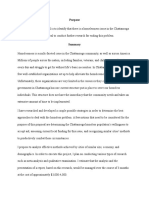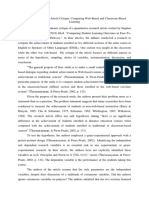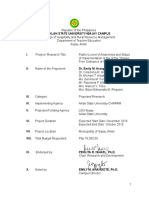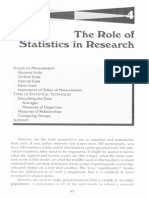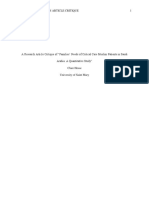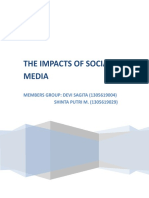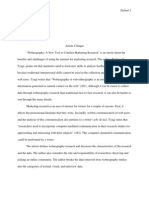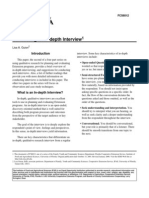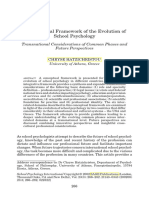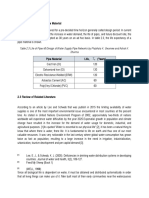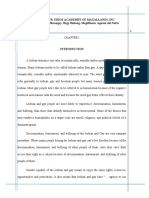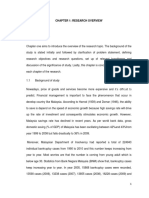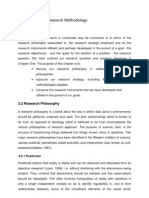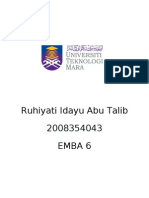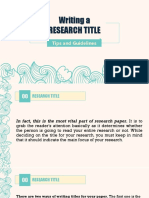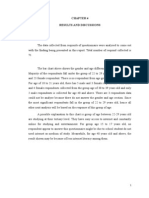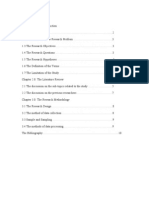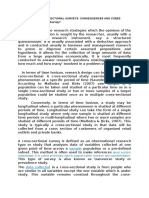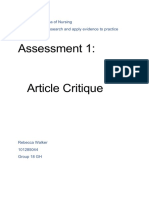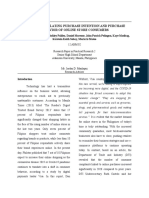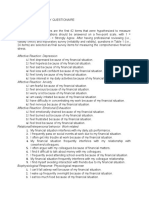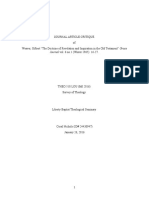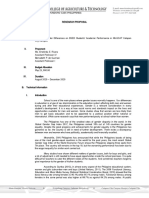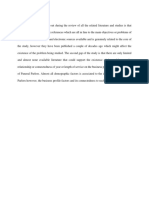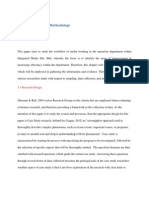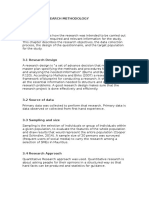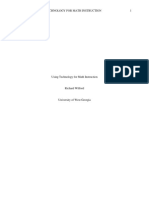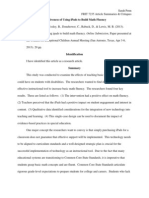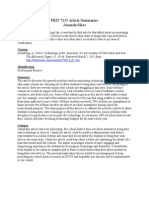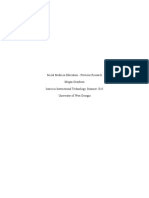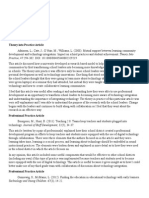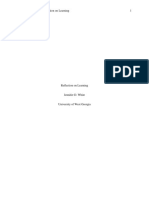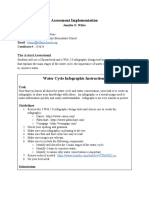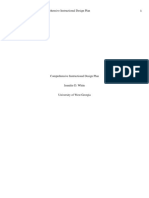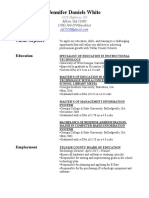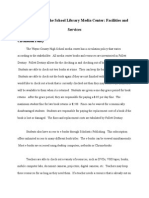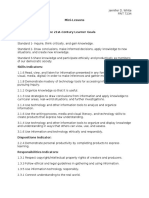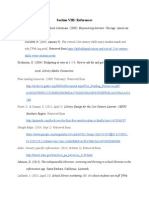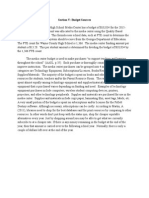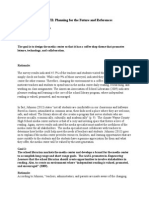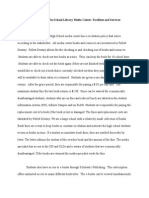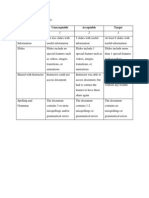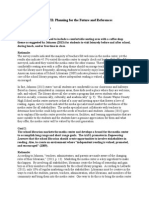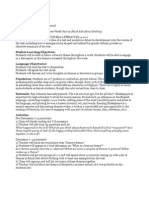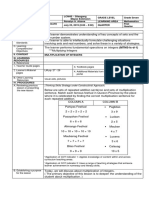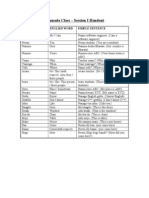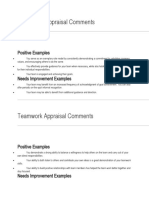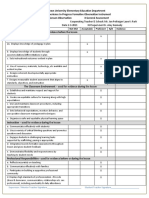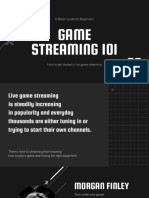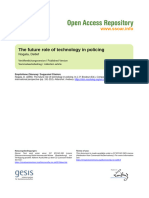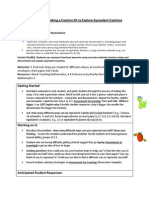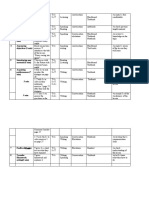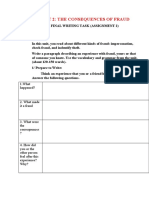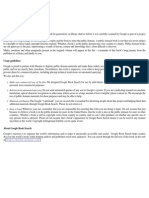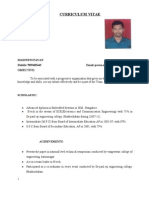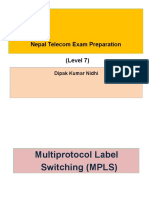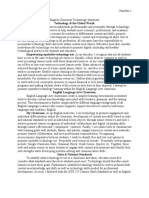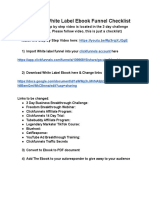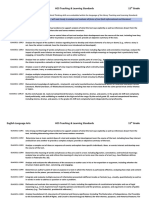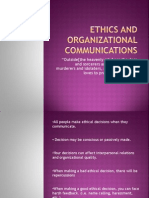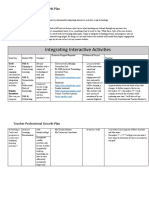Professional Documents
Culture Documents
Article Summaries and Critique
Article Summaries and Critique
Uploaded by
jdwhite55Copyright:
Available Formats
You might also like
- Research ProposalDocument7 pagesResearch ProposalCarly Denniston100% (1)
- Quantitative Research Article CritiqueDocument3 pagesQuantitative Research Article CritiqueIrbaz Khan0% (1)
- CN: 3050 Internal Auditing Critique PaperDocument5 pagesCN: 3050 Internal Auditing Critique Paperlinkin soyNo ratings yet
- APA 6 BGS Qualitative Research Paper August 20142Document46 pagesAPA 6 BGS Qualitative Research Paper August 20142Jacq Calaycay100% (2)
- Research Proposal - Smoke-Free OrdinanceDocument15 pagesResearch Proposal - Smoke-Free OrdinanceEmily ArangoteNo ratings yet
- Journal CritiqueDocument6 pagesJournal CritiqueGen-GenMedranoGirayNo ratings yet
- 4 Role of Statistics in ResearchDocument8 pages4 Role of Statistics in ResearchKong Tzeh Fung100% (1)
- Final CritiqueDocument14 pagesFinal Critiqueapi-389602748No ratings yet
- Article CritiqueDocument3 pagesArticle CritiqueRegine Navarro Ricafrente0% (1)
- What Is Qualitative ResearchDocument3 pagesWhat Is Qualitative ResearchFaith EstradaNo ratings yet
- The Impacts of Social MediaDocument5 pagesThe Impacts of Social MediadevisagitaNo ratings yet
- Daily Lesson Plan English Language Year 2 Date / Day Time / Class Focus Theme Topic Content Standard Learning Standard Learning ObjectivesDocument5 pagesDaily Lesson Plan English Language Year 2 Date / Day Time / Class Focus Theme Topic Content Standard Learning Standard Learning Objectivesmuslina79No ratings yet
- Article CritiqueDocument2 pagesArticle Critiqueninafatima allamNo ratings yet
- Article CritiqueDocument4 pagesArticle CritiqueehbeyaNo ratings yet
- How To Critique A Journal ArticleDocument6 pagesHow To Critique A Journal Articlecroiman100% (3)
- Social InclusionDocument85 pagesSocial InclusionAashish BhandariNo ratings yet
- In Depth InterviewDocument4 pagesIn Depth Interviewpopovici_k4773No ratings yet
- Sample Quantitative ResearchDocument62 pagesSample Quantitative ResearchChimar DhineeshaNo ratings yet
- A Conceptual Framework of The Evolution of School PsychologyDocument17 pagesA Conceptual Framework of The Evolution of School PsychologyFernandoNo ratings yet
- Article Critique - EditedDocument5 pagesArticle Critique - EditedEphraimNo ratings yet
- RRLDocument8 pagesRRLRuel Elido100% (1)
- LGBTDocument89 pagesLGBTFrancis CrizonNo ratings yet
- Study On Factors That Contribute Saving PDFDocument62 pagesStudy On Factors That Contribute Saving PDFMarinette Valencia MedranoNo ratings yet
- Chapter Three: Research MethodologyDocument20 pagesChapter Three: Research MethodologyRogerKYChan100% (1)
- Article CritiqueDocument4 pagesArticle CritiqueruhiyatiidayuNo ratings yet
- What Is Literature ReviewDocument2 pagesWhat Is Literature ReviewSaleh RehmanNo ratings yet
- Abstract Vs Executive Summary-NHSDocument3 pagesAbstract Vs Executive Summary-NHSdillamyNo ratings yet
- A Journal Article CritiqueDocument6 pagesA Journal Article CritiqueHarry Dass EllapanNo ratings yet
- Presentation and Analysis of Data in Research Paper SampleDocument10 pagesPresentation and Analysis of Data in Research Paper SampleafnkdjwhaedkbqNo ratings yet
- Initiatives and Plans in Solving Unethical Practices in Business FieldDocument4 pagesInitiatives and Plans in Solving Unethical Practices in Business FieldEllah Ofelia Joy Soliva100% (1)
- Tips On Writing Research TitleDocument9 pagesTips On Writing Research TitleRAENA MARIE PENDRASNo ratings yet
- Chapter 4 - Result and DiscussionDocument6 pagesChapter 4 - Result and DiscussionAK47No ratings yet
- Effect of Facebook On EducationDocument10 pagesEffect of Facebook On EducationcatchardipNo ratings yet
- Positivism in Cross Sectional SurveysDocument12 pagesPositivism in Cross Sectional SurveysStephen KokoNo ratings yet
- Sample Article CritiqueDocument7 pagesSample Article CritiquerebeccaNo ratings yet
- Journal CritiqueDocument5 pagesJournal CritiquesonicbebopNo ratings yet
- Research Paper IMRAD Group 5 (12ABM02)Document11 pagesResearch Paper IMRAD Group 5 (12ABM02)Ashley PalileoNo ratings yet
- Reflective AssignmentDocument24 pagesReflective Assignmentapi-349136596No ratings yet
- Research Proposal SampleDocument24 pagesResearch Proposal Sampleatevhanz_bcNo ratings yet
- Chapter 2Document5 pagesChapter 2irisNo ratings yet
- Chapter 3Document5 pagesChapter 3Mr DamphaNo ratings yet
- Simple Random SamplingDocument10 pagesSimple Random SamplingNafees A. SiddiqueNo ratings yet
- Downloaded Survey QuestionaireDocument2 pagesDownloaded Survey QuestionaireJHON RHEY RESUERANo ratings yet
- Journal Article Critique 1Document5 pagesJournal Article Critique 1Coral Nichols100% (1)
- Impact of Social Media On Academic Performance of Graduate Students in KathmanduDocument13 pagesImpact of Social Media On Academic Performance of Graduate Students in Kathmanduchlyde numancieNo ratings yet
- GAD RESEARCH PROPOSAL On Impact of Gender DifferencesDocument4 pagesGAD RESEARCH PROPOSAL On Impact of Gender DifferencesBernadeth Fabul PalomeraNo ratings yet
- Research GapDocument1 pageResearch GapJohn Patrick MolinaNo ratings yet
- Chapter 3Document7 pagesChapter 3Nur IzanNo ratings yet
- Marketing Research ProjectDocument26 pagesMarketing Research Projectcarlos sepulvedaNo ratings yet
- Proposal RESEARCHDocument11 pagesProposal RESEARCHbequillokharelkeit2324No ratings yet
- Chapter 3Document3 pagesChapter 3Fish de PaieNo ratings yet
- Research ProposalDocument13 pagesResearch ProposalBudhathoki Yoshiko33% (3)
- Report On Descriptive Statistics and Item AnalysisDocument21 pagesReport On Descriptive Statistics and Item Analysisapi-3840189100% (1)
- Rwilford Research Assignment2 Medt8484Document14 pagesRwilford Research Assignment2 Medt8484api-483892056No ratings yet
- Pennsarah Article Summaries Critiques Frit7235Document18 pagesPennsarah Article Summaries Critiques Frit7235api-256469019No ratings yet
- Article SummariesDocument8 pagesArticle SummariesAmanda Sikes100% (1)
- DeWeeseK KADocument27 pagesDeWeeseK KAkbdeweeseNo ratings yet
- Article SummariesDocument16 pagesArticle Summariesapi-231250612No ratings yet
- Social Media in EducationDocument17 pagesSocial Media in Educationapi-301893926No ratings yet
- FinalDocument14 pagesFinalapi-261713700No ratings yet
- ArticlesummariesDocument3 pagesArticlesummariesJessica KirklandNo ratings yet
- Reflection On LearningDocument7 pagesReflection On Learningjdwhite55No ratings yet
- Personal Technology SWOT Analysis, Goals, and PlanDocument6 pagesPersonal Technology SWOT Analysis, Goals, and Planjdwhite55No ratings yet
- Instructional Design PlanDocument7 pagesInstructional Design Planjdwhite55No ratings yet
- Assessment ImplementationDocument10 pagesAssessment Implementationjdwhite55No ratings yet
- Comprehensive Instructional PlanDocument10 pagesComprehensive Instructional Planjdwhite55No ratings yet
- Jennifer Daniels White: Career ObjectiveDocument3 pagesJennifer Daniels White: Career Objectivejdwhite55No ratings yet
- 2016 Snapdragon Book Foundation Application: The Basic InfoDocument4 pages2016 Snapdragon Book Foundation Application: The Basic Infojdwhite55No ratings yet
- KA Section III: The School Library Media Center: Facilities and ServicesDocument7 pagesKA Section III: The School Library Media Center: Facilities and Servicesjdwhite55No ratings yet
- Mini-Lessons Mini-Lesson 1 AASL Standards For The 21st-Century Learner Goals StandardDocument13 pagesMini-Lessons Mini-Lesson 1 AASL Standards For The 21st-Century Learner Goals Standardjdwhite55No ratings yet
- Section VIII: References: The Critical 21st Century Skills Every Student Needs and WhyDocument3 pagesSection VIII: References: The Critical 21st Century Skills Every Student Needs and Whyjdwhite55No ratings yet
- KA Part VDocument6 pagesKA Part Vjdwhite55No ratings yet
- Lesson PlanDocument2 pagesLesson Planjdwhite55100% (1)
- Webinar CertificateDocument1 pageWebinar Certificatejdwhite55No ratings yet
- Section VII: Planning For The Future and ReferencesDocument26 pagesSection VII: Planning For The Future and Referencesjdwhite55No ratings yet
- KA Section IIIDocument7 pagesKA Section IIIjdwhite55No ratings yet
- Module 4 Assessment RubricDocument1 pageModule 4 Assessment Rubricjdwhite55No ratings yet
- Module 3 Assessment RubricDocument1 pageModule 3 Assessment Rubricjdwhite55No ratings yet
- Section VII: Planning For The Future and ReferencesDocument20 pagesSection VII: Planning For The Future and Referencesjdwhite55No ratings yet
- Module 1 Assessment RubricDocument1 pageModule 1 Assessment Rubricjdwhite55No ratings yet
- Productivity SoftwareDocument2 pagesProductivity Softwarejdwhite55No ratings yet
- Telfair County Schools AUPDocument5 pagesTelfair County Schools AUPjdwhite55No ratings yet
- Skittles: Color Count Red 3 Green 4 Yellow 5 Orange 5 Purple 4Document3 pagesSkittles: Color Count Red 3 Green 4 Yellow 5 Orange 5 Purple 4jdwhite55No ratings yet
- LP 2Document2 pagesLP 2api-284206763No ratings yet
- Lesson Plan in Multiplication of IntegersDocument3 pagesLesson Plan in Multiplication of IntegersAquenei SxahNo ratings yet
- Learn Kannada With EnglishDocument19 pagesLearn Kannada With Englishmadhu_devu9837100% (1)
- Appendix 13a - BACHELOR Internship Final Report Assessment Sheet (202012)Document4 pagesAppendix 13a - BACHELOR Internship Final Report Assessment Sheet (202012)Pang Kok OnnNo ratings yet
- Meaningful Employee Appraisal CommentsDocument6 pagesMeaningful Employee Appraisal CommentsM Son PhamNo ratings yet
- Cs Ict11 12 Ictpt Ia B 1sesion3&4Document3 pagesCs Ict11 12 Ictpt Ia B 1sesion3&4Milton Pates100% (6)
- Professional EcthicalDocument2 pagesProfessional EcthicalkalaifivestarNo ratings yet
- Thomas Pezzano Evaluation February 3Document3 pagesThomas Pezzano Evaluation February 3api-299033960No ratings yet
- Black and White Dark Tech Lines Online Game Streaming Creative PresentationDocument17 pagesBlack and White Dark Tech Lines Online Game Streaming Creative PresentationMelani LunaNo ratings yet
- Excavator BanksmanDocument2 pagesExcavator BanksmanssloneStaNo ratings yet
- Therapeutic CommunicationDocument69 pagesTherapeutic CommunicationSONGA AmriNo ratings yet
- Ssoar-1995-Nogala-The Future Role of TechnologyDocument21 pagesSsoar-1995-Nogala-The Future Role of TechnologyfidelNo ratings yet
- Grade 5 Fractions - Equiv LessonDocument3 pagesGrade 5 Fractions - Equiv LessonKugan Mahendran KgnNo ratings yet
- Quiz-4 1Document4 pagesQuiz-4 1ChristianMatthewV.BaldonasaNo ratings yet
- The Translation of PunsDocument42 pagesThe Translation of Punsliani ghustivaNo ratings yet
- Proiect de Lectie 7 Clasa A VIII-a BiraDocument2 pagesProiect de Lectie 7 Clasa A VIII-a BiraViviana BursucNo ratings yet
- Mba 3 Sem Consumer Behaviour and Marketing Communication kmbnmk01 2022Document2 pagesMba 3 Sem Consumer Behaviour and Marketing Communication kmbnmk01 2022Nomaan TanveerNo ratings yet
- Unit 2: The Consequences of Fraud: 1.what Happened?Document3 pagesUnit 2: The Consequences of Fraud: 1.what Happened?Minh QuangNo ratings yet
- Android Car Navigation User Manual0311Document65 pagesAndroid Car Navigation User Manual0311GeorgeNo ratings yet
- Peer GyntDocument328 pagesPeer GyntJeff ZhangNo ratings yet
- Curriculum Vitae: Madineni Pavan Mobile:7899405445 Email ObjectiveDocument4 pagesCurriculum Vitae: Madineni Pavan Mobile:7899405445 Email ObjectiveNaga RajuNo ratings yet
- Nepal Telecom Exam Preparation (Level 7) : Dipak Kumar NidhiDocument22 pagesNepal Telecom Exam Preparation (Level 7) : Dipak Kumar NidhiDipak Kumar NidhiNo ratings yet
- Kathryn Pawelko - Edci 410 - English Classroom Technology Statement - FinalDocument6 pagesKathryn Pawelko - Edci 410 - English Classroom Technology Statement - Finalapi-502308514No ratings yet
- Ebook Checklist 3 Day ChallengeDocument3 pagesEbook Checklist 3 Day ChallengeHhhh hfhNo ratings yet
- Henry County Teaching Learning Standards 11th GradeDocument7 pagesHenry County Teaching Learning Standards 11th Gradeapi-452924503No ratings yet
- Ethics and Organizational CommunicationsDocument7 pagesEthics and Organizational Communicationsapi-241122434No ratings yet
- Toastmasters - Speaking To InformDocument23 pagesToastmasters - Speaking To InformLeo Xs100% (1)
- Abel Professional Goals PsiiiDocument6 pagesAbel Professional Goals Psiiiapi-534986410No ratings yet
Article Summaries and Critique
Article Summaries and Critique
Uploaded by
jdwhite55Original Description:
Copyright
Available Formats
Share this document
Did you find this document useful?
Is this content inappropriate?
Report this DocumentCopyright:
Available Formats
Article Summaries and Critique
Article Summaries and Critique
Uploaded by
jdwhite55Copyright:
Available Formats
Jennifer D.
White
Article Summaries
Citation: Martin, S., Shaw, E., & Daughenbaugh, L. (2014). Using Smart Boards and
Manipulatives in the Elementary Science Classroom. Techtrends: Linking Research & Practice
To Improve Learning, 58(3), 90-96. Retrieved June 3, 2014, from Professional Development
Collection. Available through GALILEO.
Identification: Research
Summary: In this article, the authors conduct a study to evaluate the use of SMART boards and
hands-on activities in science classrooms. A survey was administered to 48 elementary schools
in the largest school district in a southeastern U.S. state. The survey objectives were to
determine if elementary science teachers were prepared to use SMART boards in the classroom,
to determine the frequency of use, and to determine reasons why the SMART boards were or
were not used in the classroom. The survey was an online survey and was sent to teachers by
email. Of the respondents, 37.4% considered themselves as tech savvy, and 56.6% considered
themselves as knowing enough to feel confident using technology in the classroom. The
remaining 6% stated they were not comfortable with using technology in the classroom. The
majority of the respondents have access to a SMART board if one is not located in their
classroom. The teachers experienced several different types of SMART board training,
including online training, workshops, and school training from fellow teachers. Only 4.2% of
the respondents stated they had never received formal training using SMART technologies. Of
the respondents, 22.2% stated they use the SMART board five days per week, 24.4% use the
SMART board three times per week, and 9.8% never use the SMART board. The top three
reasons for using a SMART board were students responded well to technology, the variety of
Jennifer D. White
resources available, and the convenience of a SMART board. This study provided the school
district with a look at the use of technology and attitudes toward technology. The school district
can use the findings to decide where they need to make improvements.
Critique: This article can be very beneficial to school districts and technology directors that are
thinking about implementing SMART boards in classrooms. The results can help them
determine the type of training that should be done for classrooms teachers that will receive
SMART boards. School districts and technology directors that already have SMART boards
implemented in the classroom can use the results to see the importance of training users on new
technologies. If users are scared of new technology then more than likely they will use it at a
minimum or never use it at all. This article helps me, as a technology director, to understand that
teachers may be scared of new technology if they have not been trained properly. I see this in
my school district every day. There are several teachers that received SMART boards several
years ago before I became the technology director, and they use the SMART board only to show
movies and videos. They do not realize the potential of the SMART board.
Jennifer D. White
Citation: Aronin, S., & Floyd, K. K. (2013). Using an iPad in Inclusive Preschool Classrooms
to Introduce STEM Concepts. TEACHING Exceptional Children, 45(4), 34-39. Retrieved June
3, 2014, from Academic Search Complete. Available through GALILEO.
Identification: Professional Practice
Summary: This article is written to help preschool teachers implement using iPads in the
classroom to introduce STEM concepts. There has been a big push in the United States to help
students excel in STEM education. In the past, early childhood education has not been a focus of
this push. It is important that educators begin this STEM push in early childhood in order to help
students be better prepared once they enter their professions. The earlier STEM is introduced to
students the better off they will be. The article explains a few reasons why iPads were the device
of choice. The article also gives suggestions for teachers to follow when introducing students to
the iPads. The most important suggestion is to explain to the students how the iPad works and
teach them the skills needed to make the iPad work. The article also suggests introducing
students to one STEM app and concept at a time. Students should work together in small groups
to learn the STEM concepts and they should take turns using the iPad. The use of iPads is highly
motivating to most students, which means it will keep their attention longer and they will be
more willing to learn in this type of environment. The article lists several STEM apps that are
recommended for preschool classrooms.
Critique: This is a well written article and could be beneficial to preschool teachers who are
implementing iPads in their classrooms. The article only recommends six apps for the preschool
classroom. It would have been nice to see a longer list. The implementation strategies stated are
beneficial to me as a school district technology director. Our school system recently purchased
Jennifer D. White
one or two iPads for each of our Pre-K classrooms. I can pass these strategies along to the
teachers as they try to determine how to use the iPads in their classrooms.
Jennifer D. White
Citation: Lightle, K. (2011). More Than Just the Technology. Science Scope, 34(9), 6-9.
Retrieved June 3, 2014, from Education Full Text. Available through GALILEO.
Identification: Theory-into-Practice
Summary: This article discusses the importance of integrating technology in the classroom in
order to improve student learning. It states lack of access to technology and lack of professional
development are two barriers to integrating technology in the classroom. Students who are in
classrooms where technology is integrated are more motivated to learn and they take ownership
of their learning. These students are also gaining skills to be successful 21
st
century learners.
Since students prefer digital learning experiences, teachers can use the levels of Blooms
taxonomy to determine what type of digital opportunities to provide to students. Andrew
Churches revised Blooms taxonomy to add descriptions to account for technology advances.
This article stresses the importance of deciding the learning goals or skills desired, before
deciding which digital tool to use to help students accomplish this goal. Each level of Churches
revised Blooms taxonomy is stated in the article along with software or Web 2.0 tools that can
be used to help students gain lower-order thinking skills and/or higher-order thinking skills.
Critique: I enjoyed reading this article and seeing how Web 2.0 tools align with the levels of
Blooms taxonomy. Educators wanting to integrate technology in their classrooms can benefit
from this article. It can give them ideas of digital tools to use. Technology plays a big part in
education and educators need to strive integrate technology in the classroom so students will
develop necessary 21
st
century skills. The use of Web 2.0 tools allows students to modify
content, create content, and collaborate with others.
Jennifer D. White
Citation: Lin, M., Hoffman, E. S., & Borengasser, C. (2013). Is Social Media Too Social for
Class? A Case Study of Twitter Use. Techtrends: Linking Research And Practice To Improve
Learning, 57(2), 39-45. Retrieved June 3, 2014, from Academic OneFile. Available through
GALILEO.
Identification: Research
Summary: This article is a case study on the use of Twitter in the classroom. The authors
studied Twitter use by undergraduate and graduate students in three classes. The instructor of
the classes offered an extra credit assignment to the class. The instructor asked the students to
create a Twitter account, follow classmates, follow class hashtags, and tweet at least 75 times
during the course. The instructor did not provide the students with any instructions on setting up
a Twitter account or how to use Twitter. The instructor used Twitter throughout the course to
deliver class information and announcements. There were 44 students who were initially
interested in the extra credit assignment, but at the end of the course only 14 students had
completed the assignment. The results of the study showed that students were not very interested
in using Twitter to collaborate with their classmates. The way Twitter was being used in the
course did not fully parallel the ways students or faculty use social media in their personal
lives. (p. 44) It is suggested that if students need to use Twitter in a course then it should be a
requirement rather than an option. It is also suggested that the instructor provide instructions for
setting up and using Twitter. Some students may not have used Twitter because they got
discouraged trying to set it up initially. Students may want to create a Twitter account for
personal use and one for educational use so they can keep their personal lives and educational
lives separate. Social media may be a good tool to use in education, but this research shows that
Twitter may not be the best tool to use.
Jennifer D. White
Critique: I was surprised at the results of this research. I would have thought Twitter would be
a popular form of communication for college students. I would have thought they would prefer
to receive class assignments and announcements through Twitter. I am not a Twitter user, but
the idea of using it as a form of class communication sounds like a good idea. I do agree with
the suggestion to have a personal account and an education/professional account. As a
technology director in a K-12 environment, I do not think Twitter would be a good form of
communication for K-12 students, but it would be a good idea for college students. In my school
district, we currently have Twitter blocked so allowing access to it could cause a problem
because of the potential for students to be able to access inappropriate material through their
personal Twitter accounts.
Jennifer D. White
Citation: Northrop, L., & Killeen, E. (2013. A Framework for Using iPads to Build Early
Literacy Skills. Reading Teacher, 66(7), 531-537. Retrieved June 3, 2014, from OmniFile Full
Text Mega. Available through GALILEO.
Identification: Professional Practice
Summary: This article describes how to integrate iPads in the classroom in order to teach early
literacy skills. The integration of technology into the classroom is very important in order for
students to gain the knowledge and skills they need to be successful in the 21
st
century.
Technology can increase student motivation and engagement, but it needs to be integrated and
used appropriately. To ensure that students are working at their instructional or independent
level, and accessing and working with the desired literacy content, the instructional framework
of gradual release of responsibility can be modified and applied to tablet use. (p. 532) The
framework consists of 4 steps. The first step is to teach the literacy concept with direct
instruction before introducing the iPad app. The second step is to explain and model the app so
students will know how the app works. The third step is to provide guided practice with the app
and the literacy skills. The fourth and final step is independent practice with the app. The
integration and use of iPads in the classroom can be very effective if it is done correctly. It is
important for teachers to realize the iPads will not take the place of direct instruction, but that it
can enhance instruction.
Critique: I enjoyed reading this article. This article would be beneficial to teachers who have
iPads or tablets in the classroom. The four step framework could help teachers implement the
use of technology. The article lists several apps that could be beneficial to early childhood
teachers who teach literacy skills. This four step framework could be beneficial to me, as a
Jennifer D. White
technology director, because the framework can be used to implement any type of student
devices, not necessarily just iPads.
Jennifer D. White
Citation: Bartsch, R. A., & Murphy, W. (2011). Examining the Effects of an Electronic
Classroom Response System on Student Engagement and Performance. Journal Of Educational
Computing Research, 44(1), 25-33. Retrieved June 3, 2014, from Education Full Text.
Available through GALILEO.
Identification: Research
Summary: The authors of this research article conduct a study to determine if electronic
classroom response systems increase student performance. It has already been hypothesized that
electronic classroom response systems increase student engagement, improve student feedback,
and improve instructor feedback. Participants in the research study were college students from a
medium-sized state university. All participants attended a lecture by the same instructor. One
group was asked to answer seven yes/no questions by raising their hands. The other group was
asked to answer the same questions using the electronic classroom response system. After the
lecture, both groups were given a survey to measure their student engagement. The results of the
study show there is a positive correlation between student engagement and student performance.
Critique: This article would be beneficial to classroom teachers who currently use electronic
classroom response systems or teachers who have access to electronic classroom response
systems but do not use them. The positive correlation between student engagement and student
performance should be an encouragement for teachers to use the devices in their classrooms.
Whenever I think about the advantages of electronic classroom response systems, I always think
of the immediate feedback students receive as well as the immediate feedback teachers receive.
The response systems can immediately grade quizzes or assignments for teachers so they do not
have to take time to grade the material. Prior to reading this article, I had not thought about an
Jennifer D. White
increase in student engagement which in turn increases student performance. This article will
help me to encourage teachers to use response systems. Every classroom in my school district
has access to Smart Technologies Smart Response software and clickers.
Jennifer D. White
Citation: Park, S. (2013). The Potential of Web 2.0 Tools to Promote Reading Engagement in a
General Education Course. Techtrends: Linking Research And Practice To Improve Learning,
57(2), 46-53. Retrieved June 3, 2014, from ERIC. Available through GALILEO.
Identification: Professional Practice
Summary: The purpose of this article is to provide college instructors with guidance in using
Web 2.0 tools in order to improve reading engagement. Prior research states most college
students do not complete assigned course readings. The article lists four Web 2.0 tools that can
be used to improve student reading engagement. The four tools are Google Docs, Blogs,
Twitter, and Facebook. The article also gives examples of how to use these tools to improve
reading engagement. Based on self-determination theory, Web 2.0 tools allow students to
perceive autonomy and feelings of competence, as well as to experience a sense of connection
with their peers and instructor. These positive learning experiences are expected to enhance
student engagement. (p. 52) These Web 2.0 tools allow students to interact with their
classmates, which may encourage them to read assigned readings so they can become involved
in class assignments or class discussions.
Critique: I was not surprised at the lack of reading engagement among college students. Most
college students feel their social life is just as important as their education. Therefore, it makes
sense that they would do just enough school work to get by and pass the course. I know I was
guilty of this when I was earning my bachelor degree. I am also probably guilty of it at times
now. This article is directed to college instructors, but I also think it can be beneficial to high
school teachers. They could use these tools to engage students.
Jennifer D. White
Citation: Hopper, S. (2014). Bringing the World to the Classroom through Videoconferencing
and Project-based Learning. Linking Research & Practice To Improve Learning, 58(3), 78-89.
Retrieved June 3, 2014, from Academic Search Complete. Available through GALILEO.
Identification: Professional Practice
Summary: This article is a case study of a Texas school that implemented videoconferencing
and project-based learning to help obtain the skills necessary to become a successful 21
st
century
learner. Some of the skills that can be developed are critical thinking, problem solving,
communication, collaboration, cultural awareness, and technology literacy. Videoconferencing
allows two or more locations to see and hear each other via the internet. Project-based learning
is learning that occurs while students work in collaborative groups on real world issues. All
videoconferencing projects and project-based learning should be developed based on curriculum
and designed around a question of inquiry. (p. 80) Global projects give students an
opportunity to meet people of different cultures as well as learn about different cultures. This
article discusses five global projects done by the Texas school. A global project rubric is
included to help evaluate projects to determine if the project was successful.
Critique: This article could be beneficial to teachers who are interested in videoconferencing
and project-based learning. Several global projects are described which can give teachers ideas
for developing projects. As the technology director, I was interested in this article to get ideas
for global projects. Our school system has video conferencing equipment, but it is never used. I
could share this article with teachers to try to encourage them to use the equipment.
Jennifer D. White
Citation: Midler, Z. (2012). Case Profile: Zoe Midler and Google Docs. Library Technology
Reports, (2), 12-15. Retrieved June 6, 2014, from Academic OneFile. Available through
GALILEO.
Identification: Professional Practice
Summary: This article is a professional practice article in which an elementary school library
media specialist, Zoe Midler, describes how she uses Google Docs to help enhance research
skills for 5
th
grade students in her school. The school she works for is a Google Apps for
Education school. Most teachers use Google Docs on a regular basis to provide class
instructions and assignments to students. Students use Google Docs to submit their work and to
work collaboratively with other students. The 5
th
grade students were given an assignment every
week. The assignment required the students to answer a set of research questions on a particular
topic. As students began to work on the assignment, Midler began to realize students did not
know how to search for facts, and they did not know how to determine if a source was credible.
Midler also learned that parents of the students began to get frustrated with the weekly
assignments for the same reasons. Midler decided she wanted to create library media center tips
for the students as they worked on this project. Midler asked the 5
th
grade teacher to share the
assignment with her in Google Docs and to give her rights to edit the document. Midler began
making changes to the document and added tips to conducting research. Some of the tips
included using SafeSearch Resources, creating citations for sources, and determining keywords
for searches. As Midler add these tips to the Google Doc, the changes were immediately
available for students and parents to see on the teachers website. Students and parents became
more comfortable doing research because of the tips and guidelines provided by Midler.
Jennifer D. White
Critique: Google Apps for Education is a very powerful tool that can be used in numerous
ways. The best part about Google Apps for Education is that it is free. I enjoyed reading this
article and seeing how the teacher and library media specialist worked together to make the
weekly assignments easier for the students to understand. This year, our school system
purchased 350 Google Chromebooks for all math and science classes in grades 3 5. I hope that
teachers begin to use Google Apps to allow students to collaborate and submit assignments.
Many teachers were hesitant to receive the Chromebooks because they knew they would no
longer have access to Microsoft PowerPoint and Word for students to complete assignments. As
the technology director, my hope is the teachers will accept the challenge of doing things in a
new way and be successful. The advantages of using Google Apps are much greater than using
Microsoft Office. Google Apps allows for simultaneous collaboration that shows real time
changes to documents. Google Apps also allows for access to documents anytime from
anywhere.
You might also like
- Research ProposalDocument7 pagesResearch ProposalCarly Denniston100% (1)
- Quantitative Research Article CritiqueDocument3 pagesQuantitative Research Article CritiqueIrbaz Khan0% (1)
- CN: 3050 Internal Auditing Critique PaperDocument5 pagesCN: 3050 Internal Auditing Critique Paperlinkin soyNo ratings yet
- APA 6 BGS Qualitative Research Paper August 20142Document46 pagesAPA 6 BGS Qualitative Research Paper August 20142Jacq Calaycay100% (2)
- Research Proposal - Smoke-Free OrdinanceDocument15 pagesResearch Proposal - Smoke-Free OrdinanceEmily ArangoteNo ratings yet
- Journal CritiqueDocument6 pagesJournal CritiqueGen-GenMedranoGirayNo ratings yet
- 4 Role of Statistics in ResearchDocument8 pages4 Role of Statistics in ResearchKong Tzeh Fung100% (1)
- Final CritiqueDocument14 pagesFinal Critiqueapi-389602748No ratings yet
- Article CritiqueDocument3 pagesArticle CritiqueRegine Navarro Ricafrente0% (1)
- What Is Qualitative ResearchDocument3 pagesWhat Is Qualitative ResearchFaith EstradaNo ratings yet
- The Impacts of Social MediaDocument5 pagesThe Impacts of Social MediadevisagitaNo ratings yet
- Daily Lesson Plan English Language Year 2 Date / Day Time / Class Focus Theme Topic Content Standard Learning Standard Learning ObjectivesDocument5 pagesDaily Lesson Plan English Language Year 2 Date / Day Time / Class Focus Theme Topic Content Standard Learning Standard Learning Objectivesmuslina79No ratings yet
- Article CritiqueDocument2 pagesArticle Critiqueninafatima allamNo ratings yet
- Article CritiqueDocument4 pagesArticle CritiqueehbeyaNo ratings yet
- How To Critique A Journal ArticleDocument6 pagesHow To Critique A Journal Articlecroiman100% (3)
- Social InclusionDocument85 pagesSocial InclusionAashish BhandariNo ratings yet
- In Depth InterviewDocument4 pagesIn Depth Interviewpopovici_k4773No ratings yet
- Sample Quantitative ResearchDocument62 pagesSample Quantitative ResearchChimar DhineeshaNo ratings yet
- A Conceptual Framework of The Evolution of School PsychologyDocument17 pagesA Conceptual Framework of The Evolution of School PsychologyFernandoNo ratings yet
- Article Critique - EditedDocument5 pagesArticle Critique - EditedEphraimNo ratings yet
- RRLDocument8 pagesRRLRuel Elido100% (1)
- LGBTDocument89 pagesLGBTFrancis CrizonNo ratings yet
- Study On Factors That Contribute Saving PDFDocument62 pagesStudy On Factors That Contribute Saving PDFMarinette Valencia MedranoNo ratings yet
- Chapter Three: Research MethodologyDocument20 pagesChapter Three: Research MethodologyRogerKYChan100% (1)
- Article CritiqueDocument4 pagesArticle CritiqueruhiyatiidayuNo ratings yet
- What Is Literature ReviewDocument2 pagesWhat Is Literature ReviewSaleh RehmanNo ratings yet
- Abstract Vs Executive Summary-NHSDocument3 pagesAbstract Vs Executive Summary-NHSdillamyNo ratings yet
- A Journal Article CritiqueDocument6 pagesA Journal Article CritiqueHarry Dass EllapanNo ratings yet
- Presentation and Analysis of Data in Research Paper SampleDocument10 pagesPresentation and Analysis of Data in Research Paper SampleafnkdjwhaedkbqNo ratings yet
- Initiatives and Plans in Solving Unethical Practices in Business FieldDocument4 pagesInitiatives and Plans in Solving Unethical Practices in Business FieldEllah Ofelia Joy Soliva100% (1)
- Tips On Writing Research TitleDocument9 pagesTips On Writing Research TitleRAENA MARIE PENDRASNo ratings yet
- Chapter 4 - Result and DiscussionDocument6 pagesChapter 4 - Result and DiscussionAK47No ratings yet
- Effect of Facebook On EducationDocument10 pagesEffect of Facebook On EducationcatchardipNo ratings yet
- Positivism in Cross Sectional SurveysDocument12 pagesPositivism in Cross Sectional SurveysStephen KokoNo ratings yet
- Sample Article CritiqueDocument7 pagesSample Article CritiquerebeccaNo ratings yet
- Journal CritiqueDocument5 pagesJournal CritiquesonicbebopNo ratings yet
- Research Paper IMRAD Group 5 (12ABM02)Document11 pagesResearch Paper IMRAD Group 5 (12ABM02)Ashley PalileoNo ratings yet
- Reflective AssignmentDocument24 pagesReflective Assignmentapi-349136596No ratings yet
- Research Proposal SampleDocument24 pagesResearch Proposal Sampleatevhanz_bcNo ratings yet
- Chapter 2Document5 pagesChapter 2irisNo ratings yet
- Chapter 3Document5 pagesChapter 3Mr DamphaNo ratings yet
- Simple Random SamplingDocument10 pagesSimple Random SamplingNafees A. SiddiqueNo ratings yet
- Downloaded Survey QuestionaireDocument2 pagesDownloaded Survey QuestionaireJHON RHEY RESUERANo ratings yet
- Journal Article Critique 1Document5 pagesJournal Article Critique 1Coral Nichols100% (1)
- Impact of Social Media On Academic Performance of Graduate Students in KathmanduDocument13 pagesImpact of Social Media On Academic Performance of Graduate Students in Kathmanduchlyde numancieNo ratings yet
- GAD RESEARCH PROPOSAL On Impact of Gender DifferencesDocument4 pagesGAD RESEARCH PROPOSAL On Impact of Gender DifferencesBernadeth Fabul PalomeraNo ratings yet
- Research GapDocument1 pageResearch GapJohn Patrick MolinaNo ratings yet
- Chapter 3Document7 pagesChapter 3Nur IzanNo ratings yet
- Marketing Research ProjectDocument26 pagesMarketing Research Projectcarlos sepulvedaNo ratings yet
- Proposal RESEARCHDocument11 pagesProposal RESEARCHbequillokharelkeit2324No ratings yet
- Chapter 3Document3 pagesChapter 3Fish de PaieNo ratings yet
- Research ProposalDocument13 pagesResearch ProposalBudhathoki Yoshiko33% (3)
- Report On Descriptive Statistics and Item AnalysisDocument21 pagesReport On Descriptive Statistics and Item Analysisapi-3840189100% (1)
- Rwilford Research Assignment2 Medt8484Document14 pagesRwilford Research Assignment2 Medt8484api-483892056No ratings yet
- Pennsarah Article Summaries Critiques Frit7235Document18 pagesPennsarah Article Summaries Critiques Frit7235api-256469019No ratings yet
- Article SummariesDocument8 pagesArticle SummariesAmanda Sikes100% (1)
- DeWeeseK KADocument27 pagesDeWeeseK KAkbdeweeseNo ratings yet
- Article SummariesDocument16 pagesArticle Summariesapi-231250612No ratings yet
- Social Media in EducationDocument17 pagesSocial Media in Educationapi-301893926No ratings yet
- FinalDocument14 pagesFinalapi-261713700No ratings yet
- ArticlesummariesDocument3 pagesArticlesummariesJessica KirklandNo ratings yet
- Reflection On LearningDocument7 pagesReflection On Learningjdwhite55No ratings yet
- Personal Technology SWOT Analysis, Goals, and PlanDocument6 pagesPersonal Technology SWOT Analysis, Goals, and Planjdwhite55No ratings yet
- Instructional Design PlanDocument7 pagesInstructional Design Planjdwhite55No ratings yet
- Assessment ImplementationDocument10 pagesAssessment Implementationjdwhite55No ratings yet
- Comprehensive Instructional PlanDocument10 pagesComprehensive Instructional Planjdwhite55No ratings yet
- Jennifer Daniels White: Career ObjectiveDocument3 pagesJennifer Daniels White: Career Objectivejdwhite55No ratings yet
- 2016 Snapdragon Book Foundation Application: The Basic InfoDocument4 pages2016 Snapdragon Book Foundation Application: The Basic Infojdwhite55No ratings yet
- KA Section III: The School Library Media Center: Facilities and ServicesDocument7 pagesKA Section III: The School Library Media Center: Facilities and Servicesjdwhite55No ratings yet
- Mini-Lessons Mini-Lesson 1 AASL Standards For The 21st-Century Learner Goals StandardDocument13 pagesMini-Lessons Mini-Lesson 1 AASL Standards For The 21st-Century Learner Goals Standardjdwhite55No ratings yet
- Section VIII: References: The Critical 21st Century Skills Every Student Needs and WhyDocument3 pagesSection VIII: References: The Critical 21st Century Skills Every Student Needs and Whyjdwhite55No ratings yet
- KA Part VDocument6 pagesKA Part Vjdwhite55No ratings yet
- Lesson PlanDocument2 pagesLesson Planjdwhite55100% (1)
- Webinar CertificateDocument1 pageWebinar Certificatejdwhite55No ratings yet
- Section VII: Planning For The Future and ReferencesDocument26 pagesSection VII: Planning For The Future and Referencesjdwhite55No ratings yet
- KA Section IIIDocument7 pagesKA Section IIIjdwhite55No ratings yet
- Module 4 Assessment RubricDocument1 pageModule 4 Assessment Rubricjdwhite55No ratings yet
- Module 3 Assessment RubricDocument1 pageModule 3 Assessment Rubricjdwhite55No ratings yet
- Section VII: Planning For The Future and ReferencesDocument20 pagesSection VII: Planning For The Future and Referencesjdwhite55No ratings yet
- Module 1 Assessment RubricDocument1 pageModule 1 Assessment Rubricjdwhite55No ratings yet
- Productivity SoftwareDocument2 pagesProductivity Softwarejdwhite55No ratings yet
- Telfair County Schools AUPDocument5 pagesTelfair County Schools AUPjdwhite55No ratings yet
- Skittles: Color Count Red 3 Green 4 Yellow 5 Orange 5 Purple 4Document3 pagesSkittles: Color Count Red 3 Green 4 Yellow 5 Orange 5 Purple 4jdwhite55No ratings yet
- LP 2Document2 pagesLP 2api-284206763No ratings yet
- Lesson Plan in Multiplication of IntegersDocument3 pagesLesson Plan in Multiplication of IntegersAquenei SxahNo ratings yet
- Learn Kannada With EnglishDocument19 pagesLearn Kannada With Englishmadhu_devu9837100% (1)
- Appendix 13a - BACHELOR Internship Final Report Assessment Sheet (202012)Document4 pagesAppendix 13a - BACHELOR Internship Final Report Assessment Sheet (202012)Pang Kok OnnNo ratings yet
- Meaningful Employee Appraisal CommentsDocument6 pagesMeaningful Employee Appraisal CommentsM Son PhamNo ratings yet
- Cs Ict11 12 Ictpt Ia B 1sesion3&4Document3 pagesCs Ict11 12 Ictpt Ia B 1sesion3&4Milton Pates100% (6)
- Professional EcthicalDocument2 pagesProfessional EcthicalkalaifivestarNo ratings yet
- Thomas Pezzano Evaluation February 3Document3 pagesThomas Pezzano Evaluation February 3api-299033960No ratings yet
- Black and White Dark Tech Lines Online Game Streaming Creative PresentationDocument17 pagesBlack and White Dark Tech Lines Online Game Streaming Creative PresentationMelani LunaNo ratings yet
- Excavator BanksmanDocument2 pagesExcavator BanksmanssloneStaNo ratings yet
- Therapeutic CommunicationDocument69 pagesTherapeutic CommunicationSONGA AmriNo ratings yet
- Ssoar-1995-Nogala-The Future Role of TechnologyDocument21 pagesSsoar-1995-Nogala-The Future Role of TechnologyfidelNo ratings yet
- Grade 5 Fractions - Equiv LessonDocument3 pagesGrade 5 Fractions - Equiv LessonKugan Mahendran KgnNo ratings yet
- Quiz-4 1Document4 pagesQuiz-4 1ChristianMatthewV.BaldonasaNo ratings yet
- The Translation of PunsDocument42 pagesThe Translation of Punsliani ghustivaNo ratings yet
- Proiect de Lectie 7 Clasa A VIII-a BiraDocument2 pagesProiect de Lectie 7 Clasa A VIII-a BiraViviana BursucNo ratings yet
- Mba 3 Sem Consumer Behaviour and Marketing Communication kmbnmk01 2022Document2 pagesMba 3 Sem Consumer Behaviour and Marketing Communication kmbnmk01 2022Nomaan TanveerNo ratings yet
- Unit 2: The Consequences of Fraud: 1.what Happened?Document3 pagesUnit 2: The Consequences of Fraud: 1.what Happened?Minh QuangNo ratings yet
- Android Car Navigation User Manual0311Document65 pagesAndroid Car Navigation User Manual0311GeorgeNo ratings yet
- Peer GyntDocument328 pagesPeer GyntJeff ZhangNo ratings yet
- Curriculum Vitae: Madineni Pavan Mobile:7899405445 Email ObjectiveDocument4 pagesCurriculum Vitae: Madineni Pavan Mobile:7899405445 Email ObjectiveNaga RajuNo ratings yet
- Nepal Telecom Exam Preparation (Level 7) : Dipak Kumar NidhiDocument22 pagesNepal Telecom Exam Preparation (Level 7) : Dipak Kumar NidhiDipak Kumar NidhiNo ratings yet
- Kathryn Pawelko - Edci 410 - English Classroom Technology Statement - FinalDocument6 pagesKathryn Pawelko - Edci 410 - English Classroom Technology Statement - Finalapi-502308514No ratings yet
- Ebook Checklist 3 Day ChallengeDocument3 pagesEbook Checklist 3 Day ChallengeHhhh hfhNo ratings yet
- Henry County Teaching Learning Standards 11th GradeDocument7 pagesHenry County Teaching Learning Standards 11th Gradeapi-452924503No ratings yet
- Ethics and Organizational CommunicationsDocument7 pagesEthics and Organizational Communicationsapi-241122434No ratings yet
- Toastmasters - Speaking To InformDocument23 pagesToastmasters - Speaking To InformLeo Xs100% (1)
- Abel Professional Goals PsiiiDocument6 pagesAbel Professional Goals Psiiiapi-534986410No ratings yet
